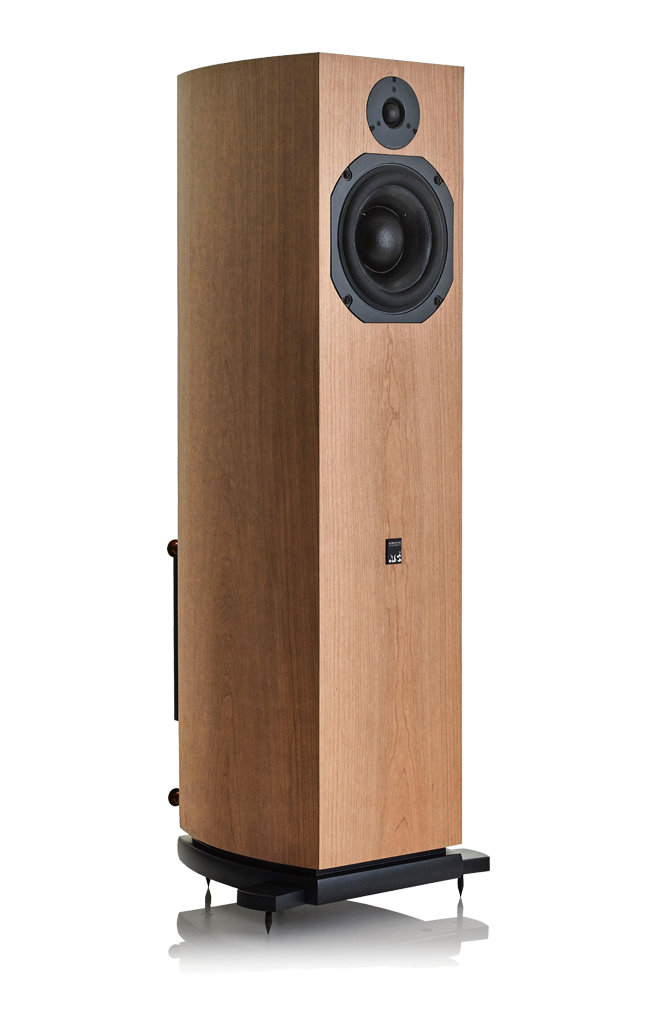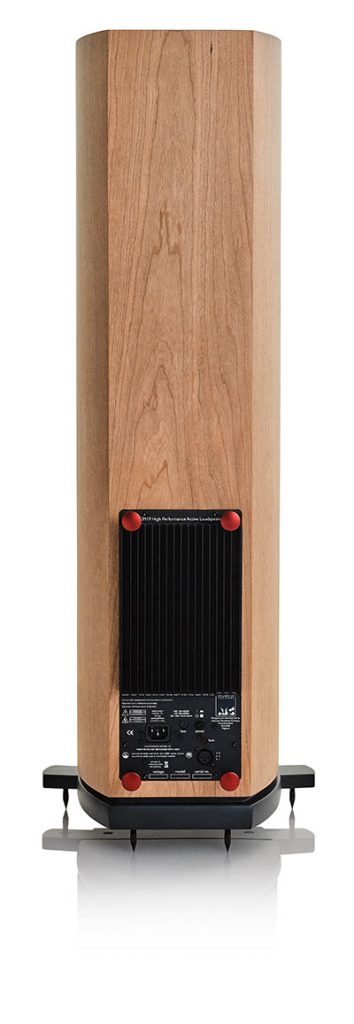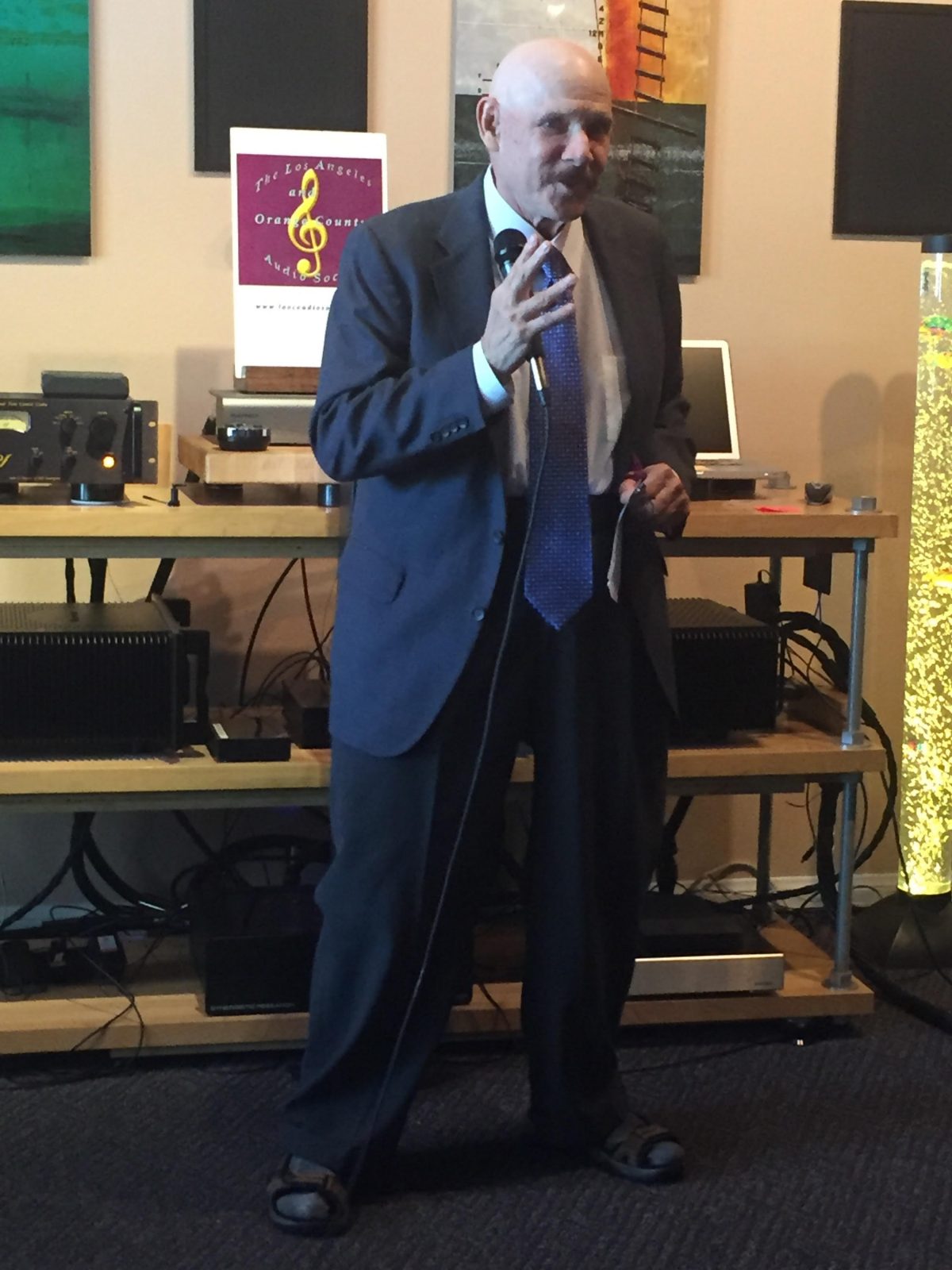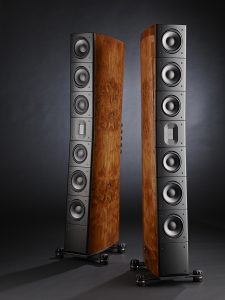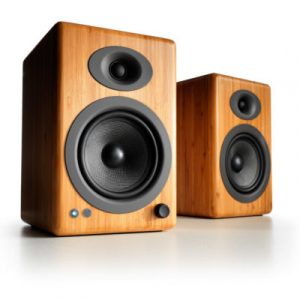If anyone out there has been following my reviews, you may know that I like active powered loudspeakers (such as the ATC SCM19AT reviewed here). My leanings in this direction are mainly technical, but backed up by certain exemplary sonic characteristics. By technical I mean that active loudspeakers where amplifiers, cables, crossovers, and speakers are integrated together in the same enclosure, have the potential to sound better than the current audiophile system paradigm where just about everything is separate. Why is this so? Many reasons, but stated most fundamentally, by integrating the active and passive components, and the electrical and electro-mechanical ones together in the same box, the audio system designer can optimize the design for what they think is the best sound for the money. They can do this with the knowledge that the consumer can't muck up the works by putting together two pieces that don't work well together. The integrated approach should also be cheaper in terms of performance value per dollar of cost. I'll have more to say about these points as we go along in the review. Indeed, most of the audio universe is moving in the direction of integration as seen in the worlds of pro audio, computer audio, portable audio, and also home theater. A notable exception to this trend is the audiophile niche
Now having said all this I have to admit I don't much practice what I preach. I do have a set of active Audioengine speakers for my computer, but my main stereo rig is of conventional architecture with all separate components and a nest of snake-like cables to connect it all. Why? First, as an equipment reviewer I need to be able to swap individual components in and out. If I were to switch my reference system to an active loudspeaker system I would have to retire to reviewing source components and other active loudspeakers only. Second, I haven't found an active loudspeaker system that I like more than my separates, although I do like some of the new models from Vandersteen, Von Schweikert, and others that have powered woofers.
The speaker under review is a model in the ATC Entry series designated the SCM19AT Active Tower Speaker listing for $9999 in the US. On the web site this model is called the SCM19A. It is a two-way system utilizing the SH25-76 25mm soft dome tweeter and a powerful 150mm SL mid/bass driver. Both drive units are sourced from ATC in England. The same drivers are used in the passive bookshelf SCM19 model. The ATC SCM19ATs are relatively small floor-standers standing just 38.5" tall and 9". wide at the front face. The cabinet sides are bowed out by about 2" to add strength and to help reduce standing waves. Outrigger feet add another couple of inches to the amount of floor space needed, but visually the speakers can easily blend into most rooms. Gray perforated metal grills are magnetically attached. The cabinets are 12" deep, but the heat sink for the amplifiers near the bottom rear extends back another 2" beyond that. The finish on the cabinets is a very handsome cherry satin and the workmanship is terrific.
Each speaker contains two Class AB MOSFET amplifiers designed to match their individual drive units. The tweeter amplifier is nominally rated at 32 W while the mid/bass amplifier produces 150W. Both amplifiers have recently been improved to reduce noise and distortion. Midband harmonic distortion is rated at 0.002%. Intermodulation distortion is usually lower in active loudspeakers compared to similar passive ones when separate amplifiers are used for multiple drive units. Each amplifier watt goes further in an active speaker because there are no losses from crossover components and speaker cables in the typical passive speaker set up. The 150W ATC amplifier is equivalent to a 200 - 250W amp used in a passive speaker configuration.
The ATC amplifiers are fed at the input with a two-way active crossover featuring "2nd order modified Butterworth circuitry with phase compensation for each crossover point" according to ATC. The crossover is at 2500Hz. Using an active crossover rather than a passive one allows for phase compensation at the crossover point to enhance the coherency around the crossover frequency resulting in improved tonal balance and imaging. Pinpoint imaging is one of the outstanding characteristics of the 19ATs as you will read below. Using active crossovers at the input of the amplifier instead of a passive crossover at the output isolates the crossover behavior from changes in the speaker coil impedance with frequency and with temperature.
Although the SCM19AT deserves points for its integrated design of speaker, cabinet, and electronics, I feel the real champ here is the new ATC-designed and built dual suspension 25mm soft dome tweeter. The specified frequency range of the tweeter is 2.5kHz to 22kHz. I was tremendously impressed by the high end response of the SCM19ATs for its transparency, smoothness, and definition. I never heard a harsh sound out of it. It compared very favorably with the ceramic tweeter in my own Marten Django XLs, which is really quite outstanding. I have heard less distinguished high ends from some well-known speakers costing two or three times more than the ATCs, even without the amplifiers. I was impressed by how it handled very soft treble tones and could then immediately ramp up to play very loudly. In fact, the dynamic range capability of the SCM19AT is hugely impressive. It can play very, very loud without distress. The specified maximum SPL is 108dB and I have no doubt it can achieve that (I only hit about 101dB according to my sound pressure meter before by ears, not the speaker, began to object). The ATC tweeter is only bettered by more expensive tweeters in its resolution of low level details.
The 150 mm SL mid/bass is also an overachiever for its size. It has a 75 mm dome in the center that helps with the upper end of its range. The low end response is specified down to 54Hz (-6dB), but subjectively in my room it extended significantly lower than that, probably helped some by room modes. The SCM19AT is a sealed box design so the roll-off in the bass is slower compared to reflex-loaded designs. Hence, they more readily pick up some help from room reinforcement. I did perform a measurement of the bass response in my room and at my listening position using a test CD with 1/3 octave warble tones and the Audio Tools app on my phone. I noted a small trough in the 80 - 125Hz range (probably room related cancellation), but the low end was basically flat to 50Hz and rolled off slowly from there. The 31.5Hz band was still very strong although diminished in level.
I inserted the ATC speakers into my all-tube my reference system consisting of the E.A.R. 868 preamp, and E.A.R. Acute III CD/DAC. I was able to turn off the E.A.R. 890 amp since the speakers have their own amplifiers. My turntable is the Townshend Rock 7 with the high output London Reference Cartridge. I use a variety of interconnects and power cables, but for this review I connected the speakers and preamp with 2.5 m length Kubala-Sosna Elation balanced interconnects, the best I have. Be aware that these interconnects cost almost as much as the speakers, but I know them to be best at getting the most out of my preamp. Note that the ATC speakers accept only balanced interconnects. You would have to use a suitable adapter if your preamp has only single-ended outputs.
I initially used the SCM19ATs with the stock power cords that are very mediocre in appearance and construction. Later, I substituted Kubala-Sosna Emotion power cables. The sound was notably better with the K-S cords featuring greater detail and texture in both the midrange and treble and a more dynamic sound. But, the difference was not as great as I expected. I strongly encourage you to upgrade the power cords if you buy the ATCs but you probably don't need to go crazy. The power cords were plugged into my WyWires Power Broker and thence into my dedicated duplex power outlet, isolated from the other AC power in my house. Comparisons were done with the same front end stuff, but with the E.A.R. 890 power amp and Marten Django XL speakers connected with Kubala-Sosna Emotion speaker cables. For those not familiar with the Martens, they have three 8" (200 mm) aluminum woofers, plus ceramic midrange and tweeter drivers from Accuton.
I was advised the speakers require 50 to 100 hours of break-in so I set them up to play whenever I left the house to serenade my pets during a week or so. Even during this period, I could tell the SCM19ATs were something special. In particular, whenever a vocal recording came up I was immediately distracted to come sit down and listen. I did notice the low frequencies were very tight, somewhat overdamped I thought even for a closed box design. At times the high end was a little lumpy, but I continued to tinker with speaker spacing and toe-in and that seemed to help. These floor-standers are quite a bit shorter than my reference Marten Django XLs. On the Djangos the tweeters sit about 42 inches off the floor which places them a few inches above my ears when I sit at my listening chair. I also have them tipped back slightly to raise the tweeter axis a bit more, and they are toed in only a few degrees. The ATC tweeters, on the other hand, are only about 37 inches off the floor, which makes them just about equal to ear height for me. I found the most satisfactory blend when I toed-in the speakers so they were pointing slightly to the sides of my ears and not directly at me as suggested in the manual. The manual also recommends an equilateral triangle set up for the speakers with the separation between the left and right channel speakers equal to the distance from the speaker plane to listening position. I tried this and it sounded good but tinkered some more. By placing the speakers a little closer together, I got better coupling of the bass and a slight improvement in low-end extension that I preferred. So, I ended up with the speakers about 7 feet apart and 8 feet from my listening spot. They were also about four feet in front of the forward wall, which I've found to be optimum in my room. Sidewalls are very far away in my installation so not an issue, but sidewall reflections could be a concern in other rooms but I could not assess that.
When I review speakers I usually play several CDs that I'm very familiar with first to get an overall impression, and then I bring out other music in digital and analog form to delve deeper. My first impression of the SCM19ATs was very positive, and that never waned. I immediately noticed the lifelike presentation of voices that really seemed to jump out from the speakers and exist in open space. In-concert vocal recordings were really special. One of the nicest afternoons I spent with these speakers was listening to the new Eva Cassidy release called Nightbird that captures all 31 songs Eva sang in front of an invited audience for her debut recording in 1996 Live at Blues Alley. Only seven of these songs were used on that first album, well known to audiophiles. Eva sounded just beautiful over these speakers, her voice so clear, smooth, and sweet. Words were very easy to distinguish. Images were rock solid and it was easy to pinpoint the position of the other band members behind her. The soundstage had such a natural spatial presentation that nothing stood out as being too small, too large, fuzzy or floating. Everything just seemed to be in its correct place. I have similar notes for other male and female vocals I sampled. This speaks to one of the advantages of active loudspeakers. By eliminating speaker cables and phase distortions caused by crossover components on the high power side of the amplifier, active speakers almost always provide more palpable, distinct, and stable images than all but the best passive speaker-based systems.
I ran an inadvertent experiment. I wanted to hear how the 19ATs sounded reproducing solo piano so I brought out a relatively rare CD of Ivan Moravec Plays Chopin on the VAI Audio label. These recordings were originally produced by E. Alan Silver for the old Connoisseur Society LP label in the 1960s. Part of the CD was taken from recordings made in 1965 and the last three cuts in 1969. I thoroughly enjoyed the top to bottom coherency, tonal purity, and spatiality of the recording through the 19ATs, as well as the outstanding performance by Mr. Moravec. When the recording transitioned from the 1965 recordings to the 1969 recordings I immediately noticed a shift in the spatial image. The information that comes with the CD does not say if the recording location or the piano were different from one year to the other, but it seemed like the microphones were either spaced further away from the piano, or the recording venue was larger. Either way, an easily recognizable change. I then cued up the same recording to play on my reference system with separate amplifier and speakers. This time when the recording conditions changed the change in spatial image was not nearly as easy to discern. Instead I had to listen several minutes longer to pick up subtler tonal changes in the piano to tell the 1969 recordings apart from the 1965 ones. I had already noted the precision imaging of the 19ATs in earlier listening but this experiment brought that home for me. The top-to-bottom coherency and precision imaging of active speakers is one of their signature advantages and it is executed well in the ATCs.
But, that's not all. The ATC's are capable of sounding very dramatic when the music and performance call for it, a result of their fine dynamic contrasts, tonal character, and nuance. Instruments and especially voices were realized with a vividness and transparency that were top notch. Additionally, for a small speaker, they could really fill the room and play very loud. It was fun watching the mid/bass moving energetically on some cuts I tried from Lou Reed and Daft Punk. Really fun to listen to.
Apart from the low-end extension I mentioned above, the bass response was very well defined and tight, with no apparent flab or overhang. While the speaker was breaking in I thought the bass was overdamped, but this diminished as more hours were put in on the speakers. This extended and tuneful bass really drove the music forward and made best use of every cycle of bass there was. Rarely was I aware of a lack of low end oomph. The very bottom end of some music was missing, but only because I knew it was there from listening on other systems. About the only times I was bothered by some missing low end was on certain classical orchestral recordings where I noticed some of the missing room ambiance.
The midrange was smooth and involving with no hint of problems around the crossover point. I've already told you how great these speakers sound on vocal recordings, but the same was true on instrumentals and large scale orchestras. Detail and transparency were also terrific for a speaker in this price range. I've heard better but not by much. Although I enjoyed most types of music I listened to on the SCM19ATs, the one type of music I found a little lacking was large scale classical recordings. Although the speakers did almost everything right I could not find a symphony that really got to me emotionally. Perhaps this was due to a small depression in the frequency response I noted around 100Hz, an important power zone. This aberration may have been due to my room rather than the speaker, so please don't take this as a criticism without listening for yourself. Symphonic music was delivered with notable zest and dynamics, and orchestral images were once again outstanding in their stability and detail.
In comparing the ATCs directly to my E.A.R./Marten system that costs almost three times the price, the ATC speakers hold up very well in tonality, dynamic range, definition, and transparency, and they exceed the reference in imaging solidity and detail. The Martens do produce a bigger sound that I appreciated most on classical music. Bass extended lower but not by much, and the ATC bass was better defined on some music. My reference system does put more air around individual performers and music has a bit more texture and detail. On many vocal recordings, especially female, the two systems do not sound alike but it's a toss-up as to which is better. Truly a great effort by ATC.
There are a number of reasons why active speakers have not caught on with high-end consumer audio people, much of it having to do with marketing (i.e., there are a lot more companies producing separates and they dominate the advertising pages and audio shows). It also takes a company with diverse engineering expertise to cover electronics, mechanics, electro-mechanics, and other disciplines and this is rare. ATC clearly has the engineering talent required as they have been in business over 40 years and producing active speakers for many of them. The SCM19ATs are a wonderful advancement in the state of the art of active loudspeakers. You could easily spend three times as much on comparable separate components and not do as well. I strongly encourage you to seek out the ATCs and give them a listen.
ATC SCM19AT Active Tower Speaker System
Retail $9999
ATC - Acoustic Transducer Company
www.atcloudspeakers.co.uk
U.S. Distribution
Lone Mountain Audio/ATC U.S.
7340 Smoke Ranch Road, Suite A
Las Vegas, NV 89128
Brad Lunde, (702) 307-2727
www.lonemountainaudio.com




